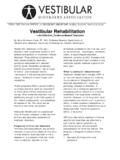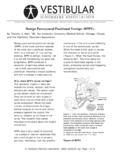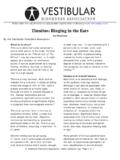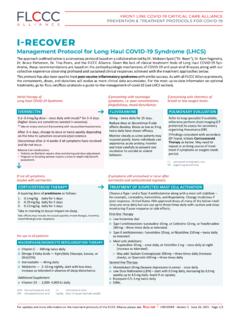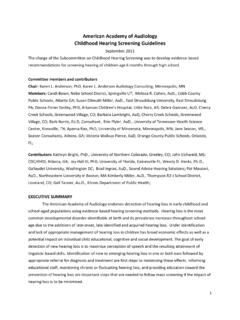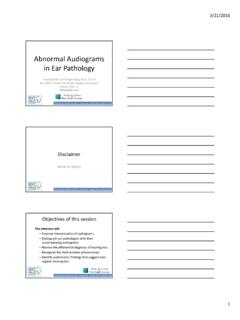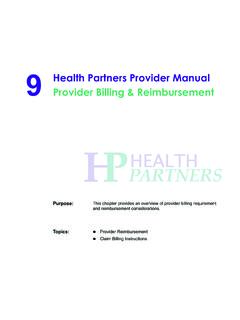Transcription of Diagnostic Tests for Vestibular Disorders - VeDA
1 Vestibular Disorders Association Page 1 of 5 PO BOX 13305 PORTLAND, OR 97213 FAX: (503) 229-8064 (800) 837-8428 Diagnostic Tests for Vestibular Problems By the Vestibular Disorders Association The inner ear s Vestibular organs and the associated nerves and brain centers form a complex system that serves many functions and can be affected by a number of outside systems. A thorough evaluation of the inner ear may therefore require several different kinds of Tests . Doctors use information from a person s medical history and findings from a physical examination as a basis for ordering Diagnostic Tests to assess the Vestibular system function and to rule out alternative causes of symptoms. Most people tolerate these Tests well. However, sometimes the Tests are fatiguing and can result in temporary unsteadiness. Specific Tests of Vestibular dysfunction Good balance and clear vision rely on a close linkage between the Vestibular organs and the eyes.
2 Head movement or other stimulation of the inner ear sends signals to the muscles of the eyes via the nervous system; this is called the vestibulo-ocular reflex, or VOR. The VOR normally generates eye movements that maintain clear vision with head movement. Electronystagmography (ENG) ENG is a battery (group) of eye-movement Tests that look for signs of Vestibular dysfunction or neurological problems by measuring nystagmus (a type of involuntary eye movements) and other eye movements. ENG Tests are the most common ones administered to people with dizziness, vertigo, and/ or balance Disorders , although the test battery and some testing methods vary widely. During ENG, eye movements are recorded and analyzed via small electrodes placed on the skin around the eyes. The electrodes attach to the skin with an adhesive, much like a small bandage. Alternatively, eye movements may be recorded by video-nystagmography (VNG) using an infrared video camera mounted inside goggles that the patient wears instead of sticky-patch electrodes.
3 One ENG/VNG test evaluates the movement of the eyes as they follow a moving target. Another observes eye movements as the head is positioned in different directions. During the caloric test (sometimes called bi-thermal caloric or mono-thermal caloric), warm or cold water or air is circulated in the ear canal Vestibular Disorders Association Page 2 of 5 to test the nystagmus response stimulated by the temperature change. Rotation Tests Rotation Tests are another way of evaluating how well the eyes and inner ear work together. For every head movement in one direction, there is eye movement in the opposite direction. With rotation Tests (which employ the same type of sticky-patch electrodes or goggles used for ENG/VNG), the examiner can record eye movements while the head is moving at various speeds. This provides additional information, beyond the ENG/ VNG, about how well the balance organs are functioning, along with their connections to the eye muscles.
4 Not all people in the diagnosis phase will need rotation Tests . There are two kinds of computerized rotation Tests : auto head rotation and rotary chair. In auto head rotation Tests , the person being tested is asked to look at a fixed target and move his/her head back and forth or up and down for short periods of time. During rotary-chair Tests , the computerized chair moves for the person being tested. For safety, a harness is worn and the head is restrained against a headrest. Rotary-chair testing usually takes place in a darkened room. A microphone and speaker in the testing room allow voice contact with the examiner, who is seated at a computer console just outside the door. As in ENG/ VNG testing, while the eye movements are recorded, the person being tested will be asked a series of simple questions that are meant to keep the mind busy and alert during the Tests . Not all rotation testing is computerized.
5 In some cases a swivel chair is used, or the doctor or other examiner simply moves the person s head with his or her hands while observing the eye movements. Vestibular evoked myogenic potential (VEMP) VEMP testing is used to evaluate whether the saccule and the inferior Vestibular nerve are intact and functioning normally. During VEMP testing, headphones are placed over the ears and small electrodes are attached with an adhesive to the skin over the neck muscles. When sound is transmitted through the headphones, the electrodes record the response of the muscle to the Vestibular stimuli. Computerized dynamic posturography (CDP) CDP Tests postural stability. While ENG/ VNG and rotation Tests assess visual- Vestibular interactions, CDP provides information about motor control or balance function under varying environ-mental conditions. This is important because the ability to maintain balance depends not only on sensory information from the vision and the Vestibular systems, but also on sensory information that the brain receives from the muscles and joints.
6 These somatosensory signals provide clues such as the direction of head turn and the texture and slope of Vestibular Disorders Association Page 3 of 5 the walking surface. CDP Tests the relationships among these three sensory inputs and records the balance and posture adjustments made by a person in response to variations in reliable information provided by the vision and somatosensory systems. The test involves standing on a platform, typically with some form of visual target to watch. The platform and/or the visual target move while pressure gauges under the platform record shifts in body weight (body sway) as the person being tested maintains balance. A safety harness is worn to prevent falling during the test. Posturography gives information about how well balance is maintained during challenging situations. It can help doctors plan other Vestibular testing, as well as assist in treatment design.
7 Hearing Tests Audiometry measures hearing function. Hearing evaluations are an important part of Vestibular diagnostics, because of the close relationship between the inner ear hearing and balance organs. Several different audiometry Tests , performed by an audiologist, may be required. These Tests are carried out in a sound-treated room with a set of headphones which also allow voice contact with the audiologist through a microphone. A person with a Vestibular disorder sometimes has his/her hearing monitored at intervals over time, especially when there is evidence of hearing loss, a sensation of fullness in the ears, or tinnitus (ringing or noise in the ears). Pure tone audiometry In pure tone audiometry testing, a response is requested when sounds are heard of different pitches through the headphones. Speech audiometry Tests Speech audiometry Tests can include speech reception threshold and word recognition (sometimes referred to as speech discrimination), where the repetition or recognition of words is requested as they are presented at different intensities.
8 tympanometry tympanometry helps detect the presence of fluid in the middle ear, among other problems, by examining the function of the middle ear and Eustachian tube, including the stiffness of the eardrum, when air-pressure changes are imposed through a soft probe that is inserted into the external ear canal. Acoustic-reflex testing Acoustic-reflex testing measures the reflex of the stapes (one of the tiny bones of the middle ear) caused by the response of the stapedius muscle when the ear is subjected to a loud sound. Electrocochleography (ECoG) Vestibular Disorders Association Page 4 of 5 ECoG measures how sound signals move from the ear along the beginning of the hearing nerve. Otoacoustic emissions (OAE) OAE testing provides information about how the hair cells of the cochlea are working by measuring the responsiveness of these hair cells to a series of clicks produced by a tiny speaker inserted into the ear canal.
9 Auditory brainstem response test (ABR; or BER, BSER, or BAER) The ABR measures how hearing signals travel from the ear to the brain and then within parts of the brain. Under certain circumstances, this test can indicate the presence of an acoustic neuroma (a rare, benign tumor of the vestibulo-cochlear nerve). It may also help identify conditions such as multiple sclerosis if they have affected the auditory pathway to the brain. Scans Magnetic resonance imaging (MRI) MRI uses a magnetic field and radio waves to produce cross-sectional images of the parts of the body being scanned. An MRI of the brain can reveal the presence of tumors, stroke damage, and other soft-tissue abnormalities that might cause dizziness or vertigo. MRIs of structures in and around the inner ear may show problems such as an acoustic neuroma. Computerized axial tomography (CAT, or CT) A CT scan is an X-ray technique that is best for studying bony structures.
10 CTs of the temporal bone (within which the inner ear resides) are often used to look for abnormalities such as fractures. Other Tests Depending on your circumstances, other Tests are possible, such as blood work or allergy Tests , in order to rule out causes of symptoms that are unrelated to the Vestibular system. References 1. Campbell K. Essential Audiology for Physicians. San Diego: Singular Publishing Group; 1997. 2. Jacobson GP, Newman CW, Kartush JM. Handbook of Balance Function Testing. San Diego: Singular Publishing Group; 1993. 3. Van den Hauwe L et al. Imaging in Patients with Vertigo. JBR-BTR. 1999;82:241 244. 4. Shepard NT, Telian SA. Practical Management of the Balance Disorder Patient. San Diego: Singular Publishing Group; 1996. Vestibular Disorders Association VEDA s publications are protected under copyright. For more information, see our permissions guide at This document is not intended as a substitute for professional health care.
